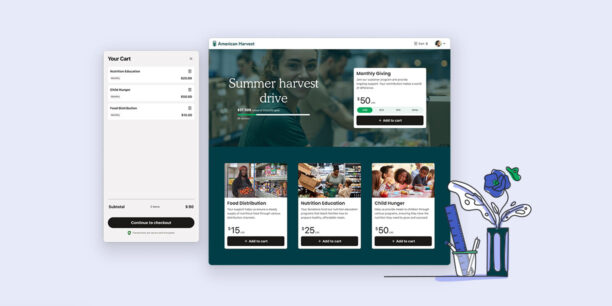Understanding Fluctuations in Your Nonprofit’s Social Traffic

Request a Demo
Learn how top nonprofits use Classy to power their fundraising.
This blog was written in collaboration with Julia Patterson, Digital Media Senior Manager of Organic Social at RKD Group, a nonprofit growth accelerator.
Social media is constantly evolving—from trends to content types to algorithm updates and more. Each of these changes can affect your visibility, create viral moments, and influence the flow of traffic to your website.
With more than 4 billion users worldwide, social media has never been more essential or relevant for your nonprofit organization. It’s critical to understand the flow of organic social traffic to effectively use it as a marketing and communication tool.
So, what do you do when you see fluctuations? What do they mean? How should your organization respond or adapt? Let’s explore these questions.
Get Strategic with Zero-Click Content
First, let’s discuss zero-click content. This is the fully contained content within a social media channel—a post, image, or video that doesn’t link somewhere else (hence, zero click).
The ultimate goal when developing a presence on social media should be to entertain, inform, and build a community. You must showcase value and convince the user that following you will benefit them through entertaining or educational content that teaches them something.
Sure, you want to drive meaningful traffic to your nonprofit’s website, but organic social requires the right balance of engaging posts and strategic links.
That’s because most algorithms prioritize zero-click content. They want users to stay in the app as long as possible, so naturally, algorithms favor posts without links that encourage users to leave the platform.
Here’s a great breakdown by channel from SparkToro:

Instead of trying to manipulate the system, play into it. Create content that provides value upfront so users can learn and get entertained without leaving the platform.
Here are good examples of zero-click content include:
- Informational carousel graphics
- How-to videos, recipe videos, tutorials
- Thread posts explaining a story or sharing information on a subject
- Longer-form thought leadership posts (think LinkedIn)
Once you share enough zero-click content, your future posts will likely be rewarded. Then, you can start to sprinkle in strategic external links—perhaps 10% or less of the time—with the focus and priority still being on providing in-app value.
Identify Essential Metrics for Performance Analysis
Now that you understand the balance of content and algorithms, let’s talk about some key metrics to monitor.
One critical item to note is that UTM codes have traditionally been the best way to see visitors entering your website from organic social. However, Apple’s recent privacy changes now strip out these parameters. This means that iPhone and iPad users don’t show up as social traffic, so it’s crucial to look at direct traffic as well.
Here are the key metrics to check to understand your traffic fluctuations:
- Impressions provide valuable insight into how many times users viewed your content.
- Reach allows you to understand how many individual users saw your content and how visible you are. Your reach is critical in identifying brand awareness.
- Engagements are crucial for understanding your content success and determining what your audience values. However, neither impressions nor reach illustrate whether a user interacted with your content. Engagements can encompass likes, comments, and shares.
- Engagement rate helps you determine the quality and relevance of your content. Out of all the people who viewed your post, how many took the next step and engaged with it?
- Audience growth is probably one of the most well-known vanity metrics, but for a good reason. Monitoring new and lost followers is essential in gauging whether your presence on social media is gaining positive responses. For example, if you’re steadily gaining followers, you’re probably on the right track. But you probably need to switch up your approach if you’re losing followers.
- Link clicks/site referrals show the number of visitors to your website who come directly from social platforms. Monitoring these is a good way to determine whether a piece of content is compelling enough for users to take the next step and learn more.
- Time on site goes hand in hand with the above metric to show you how engaging your web content is. Driving a social media user to your website is one thing. But getting them to stay is an entirely different challenge.
- Conversions allow you to see how many users took that next, final step down the marketing funnel in committing to becoming a supporter, donor, or other type of advocate.
- Conversion rate helps you understand the return on investment of your social media efforts and which content and strategies are most effective at driving those actions. Of all the people you got to jump from social media to your website, how many were intrigued and convinced to take action?
Establish a monthly reporting process to review these metrics and spot trends and outliers. You should also monitor your social performance weekly (if not daily) to spot conversations and viral boosts.
Put It into Action
You can monitor many things on social media, which can sometimes feel overwhelming. Here are some strategic tips to get more out of your organic social efforts:
Tip #1: Leverage the Appropriate Tools
Take advantage of social media management tools (like Hootsuite, Buffer, and Sprout Social) and traffic acquisition platforms (like Google Analytics), which are crucial in understanding your social performance and optimizing content accordingly. These reporting tools make tracking quicker and more efficient while diving deeper into insights.
Tip #2: Dial In on What’s Important
Narrow down your priorities on social media. Ask yourself your purpose on each platform—what you want to achieve, what success looks like, and other targeted questions. Then, develop four or five social goals to focus on (like engagements, impressions, audience growth, social shares, and site referrals). Each nonprofit will likely have different priorities, so take time to reflect and be intentional about what you hope to accomplish with your content.
Tip #3: Optimize Your Content Based on Past Success
Develop content themes that stem from top-performing content and insights gained. For example, if you continuously see that informational carousel graphics generate a high volume of social shares, a critical social goal for your organization, work to curate more content like that since your audience responds well to it.
Tip #4: Make It Scalable
Categorize your top-performing content themes into buckets that your content creators or social managers can reference and plug regularly into their upcoming content calendar. This not only helps streamline the content creation process but also places emphasis on creating content with purpose and value.
Excelling on social media can be challenging, but the key often lies in donor data. Monitoring and reporting user responses is essential for maintaining a meaningful social media presence.
You can create a valuable content calendar by identifying top and bottom-performing content and developing consistent themes. Repeat this process, incorporating new insights, to maximize your social media impact and reap the benefits of an informed strategy.
Copy Editor: Ayanna Julien

10 Social Media Post Examples That Drive Engagement
Subscribe to the Classy Blog
Get the latest fundraising tips, trends, and ideas in your inbox.
Thank you for subscribing
You signed up for emails from Classy
Request a Demo
Learn how top nonprofits use Classy to power their fundraising.
 Explore Classy.org
Explore Classy.org 

